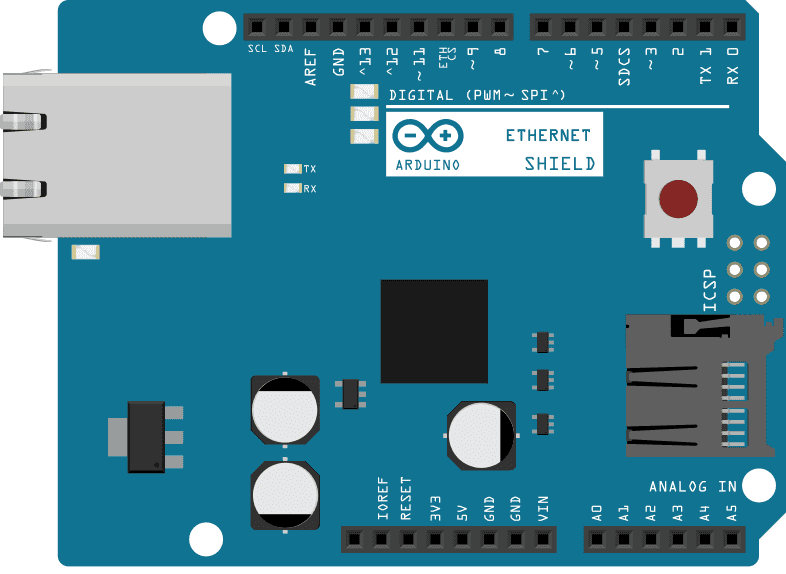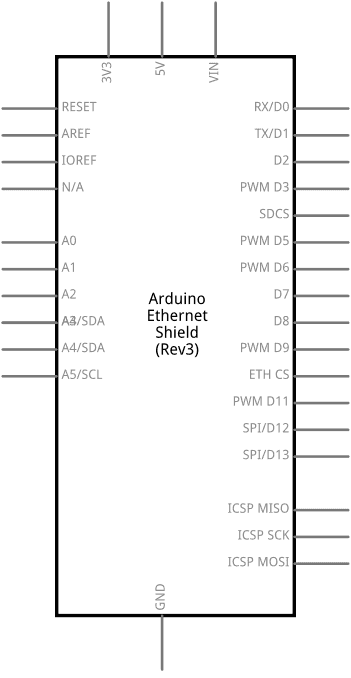Using the SD library to retrieve information over a serial port
This example shows how to read a file from a SD card using the SD library and send it over the serial port. Please click here for more information on the SD library.
Hardware Required
Arduino board
Ethernet Shield (or other board with an SD slot)
Formatted SD card with a file named "datalog.txt" containing some text
Circuit

image developed using Fritzing. For more circuit examples, see the Fritzing project page
The Arduino board has to be connected to the Ethernet Shield and also has a USB cable connected to the computer.
Schematics

image developed using Fritzing. For more circuit examples, see the Fritzing project page
Code
The code below is configured for use with an Ethernet shield, which has an onboard SD slot. In the setup(), call SD.begin(), naming pin 4 as the CS pin. This pin varies depending on the make of shield or board you are using.
On the SD card, there is a file named "datalog.txt". In the loop(), the file is opened when calling SD.open(). To send the file serially to a computer, use Serial.print(), reading the contents of the file with SD.read().
/*
SD card file dump
This example shows how to read a file from the SD card using the
SD library and send it over the serial port.
Pin numbers reflect the default SPI pins for Uno and Nano models.
The circuit:
SD card attached to SPI bus as follows:
** SDO - pin 11
** SDI - pin 12
** CLK - pin 13
** CS - depends on your SD card shield or module.
Pin 10 used here for consistency with other Arduino examples
(for MKRZero SD: SDCARD_SS_PIN)
created 22 December 2010
by Limor Fried
modified 9 Apr 2012
by Tom Igoe
This example code is in the public domain.
*/
#include <SD.h>
const int chipSelect = 10;
void setup() {
// Open serial communications and wait for port to open:
Serial.begin(9600);
// wait for Serial Monitor to connect. Needed for native USB port boards only:
while (!Serial);
Serial.print("Initializing SD card...");
if (!SD.begin(chipSelect)) {
Serial.println("initialization failed. Things to check:");
Serial.println("1. is a card inserted?");
Serial.println("2. is your wiring correct?");
Serial.println("3. did you change the chipSelect pin to match your shield or module?");
Serial.println("Note: press reset or reopen this serial monitor after fixing your issue!");
while (true);
}
Serial.println("initialization done.");
// open the file. note that only one file can be open at a time,
// so you have to close this one before opening another.
File dataFile = SD.open("datalog.txt");
// if the file is available, write to it:
if (dataFile) {
while (dataFile.available()) {
Serial.write(dataFile.read());
}
dataFile.close();
}
// if the file isn't open, pop up an error:
else {
Serial.println("error opening datalog.txt");
}
}
void loop() {
}See Also
SD library - Your reference for the SD Card library.
Notes on using SD cards - What you need to know when you use SD cards
CardInfo - Get info about your SD card.
Datalogger - How to log data from three analog sensors to an SD card.
Files - How to create and destroy an SD card file.
Listfiles - How print out the files in a directory on a SD card.
ReadWrite - How to read and write data to and from an SD card.
Last revision 2015/08/18 by SM